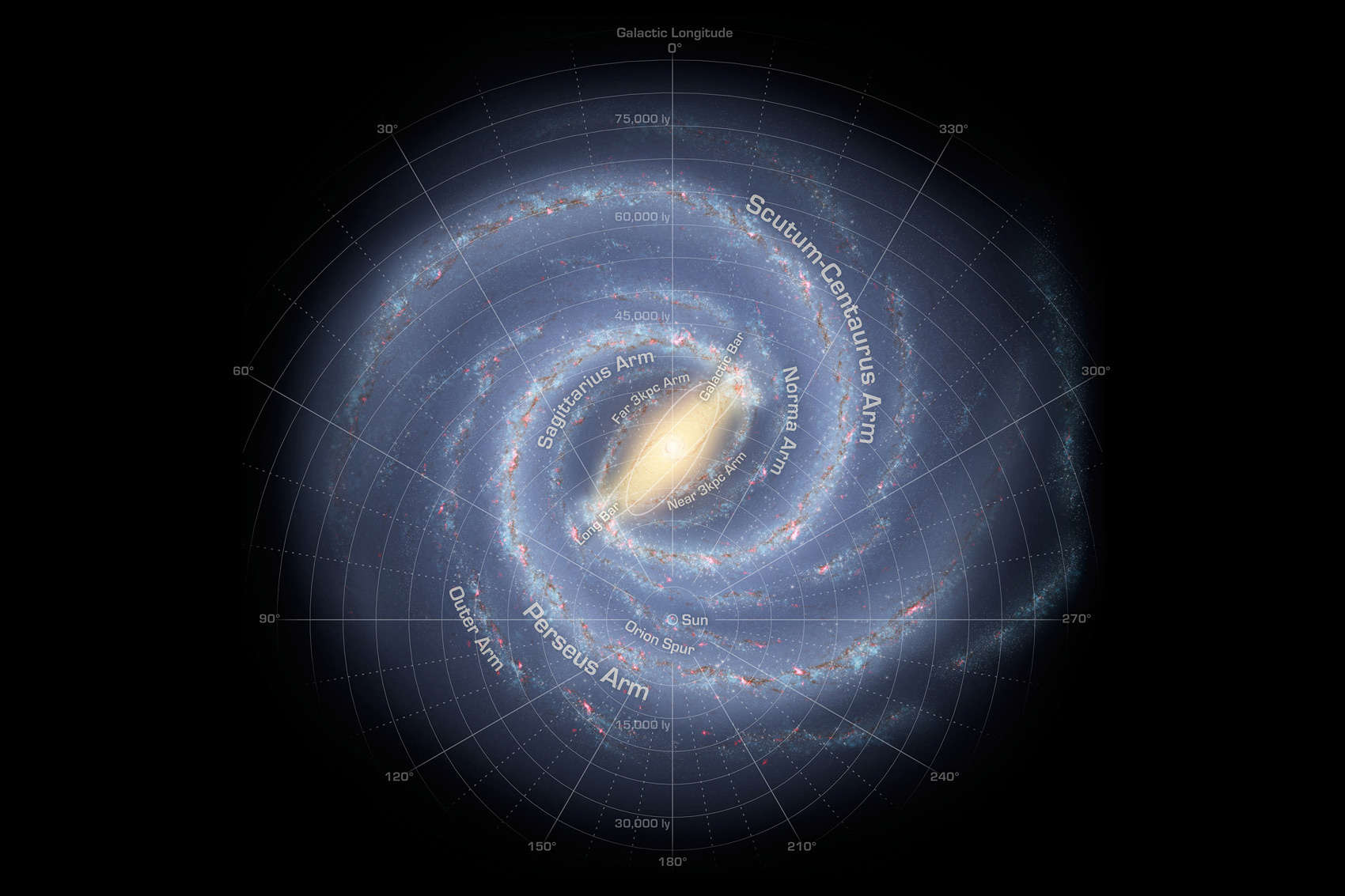Create a free profile to get unlimited access to exclusive videos, sweepstakes, and more!
How long would it take for an alien civilization to populate an entire galaxy?

Let's say there are aliens out there.
Let's also say that they are slightly more advanced technologically than we are. So, they can build ships of some kind that either a) have AI that can self-replicate if they find a planet with materials to build more probes, or 2) carry aliens with them that can settle* a suitable planet they find. They then establish themselves, grow, and send out more ships when they are capable.
How long would it take for them to populate the entire galaxy?
It's an interesting question. We want to know if We Are Alone, for example, and if we are being visited by aliens (spoiler: We are not). It's a big galaxy — the Milky Way is a flat disk about 120,000 light years across — and if you have relatively fast ships it still takes a long time to cross it.
But the premise involves exponential growth, so the spread of the settlements means more growth, which means more settlements, on and on. The aliens would spread across the galaxy in a wave. What would that look like? And how long would it take?
This problem has been tackled many times, but a recent paper by a team of astronomers (one of the authors is Jason Wright, about whom I've written many times before, like here, here, here, and here) looks at it a little differently. They make some interesting assumptions, and what they find is that even being really pessimistic the entire galaxy can be explored in less than 300 million years, far shorter than the galaxy's lifetime.
First, watch a simulation showing their results, and then we can look at their assumptions and results:
Each dot represents a star, and they are allowed to orbit the center of the galaxy due to gravity (this is critical as we'll see in a moment).
The first civilization pops up to the right of the galactic center immediately, shown as a red dot. The exploration expands the aliens to nearby stars; slowly at first, and the stars move halfway around the galaxy before new settlements are made. But then things kick into high gear rapidly, and in less than two galactic rotations the aliens basically populate most of the galaxy, especially toward the center.
Mind you, this simulation is conservative. It assumes that the ships have a range limited to 10 light years — about a dozen stars are within this distance of Earth — and travel at 1% the speed of light. Also, they assume that any planet settled by these aliens takes 100,000 years to be able to launch their own ships. That sounds like a long time, but it hardly matters. The aliens increase rapidly, and we end up with an alien-rich Milky Way (if the probes are faster and have more range then entire galaxy can be explored in less than a few million years; mind you that's nearly instantaneous compared to the age of the galaxy, even allowing a few billion years for planets abundant in heavy elements to form).
Amazingly, even if the ships are really slow, only moving at 30 kilometers per second (about the speed of interplanetary probes we have now) expansion still grows rapidly.
Some of this we've known for a while. What's new here is that the stars are allowed to move. Because it takes so long for a new settlement to be able to launch a ship, the stars move appreciably as they orbit the galaxy. Over time, this brings new stars into even the very limited range of these ships, allowing the expansion to continue. If the range is farther (10 light years is pretty limited), then the expansion can happen even more rapidly.
Because of this the settlement wave is pushed more by stellar motion than the ships themselves. We see that as the wave expands around the galaxy instead of in a growing circle around the original planet. Also, as the wave moves inward stars are closer together, so the expansion wave travels extremely rapidly toward the center.
The conclusions they draw from this are pretty cool. In simulations where the stars are not moving the wave can stall and die out, but in this one new stars can move into range (assuming the aliens have a long technological civilization lifetime; they assume 100 million years). If the lifetime is shorter, the calculations show you can get regions of the galaxy dense with civilizations surrounded by voids where no planets are settled.
That last one is interesting indeed. This means you can have planets that are suitable for settling, but still unsettled by the aliens.
That could be an answer to the so-called Fermi Paradox: If aliens have the tech, why don't we see them? They should be here by now!
The obvious answer here is that they may very well have come here, but it was a long time ago. The authors show that it's possible the Earth hasn't been visited for at least the last million years, in which case any evidence of aliens would be difficult to find, especially if their civilization lifetime is relatively short.
Another conclusion, which can be found in another paper, is that looking toward the centers of galaxies may be the best way to seek out new life. Assuming there are planets there, and they are safe to settle on, this would be the most populated part of a galaxy.
There is much, much more to all this, and Wright discusses the implications even further in his blog; see this article from 2019, and another he just wrote that follows on with some of the ideas from the new simulation.
I have always loved the idea that while we can speculate on the existence of aliens, we can also use math and physics to model how they might expand into the galaxy. And even making very conservative assumptions we can come to some very interesting conclusions about where they might be, and why we haven't seen them even if they do exist.
I have always been reticent to base any conclusions on alien psychology: Maybe they don't want to explore, or they do and have found us but leave us alone (the Zoo Hypothesis). But it only takes one besides us, and many societies of humans on our planet feel the need to explore (if for different reasons). It's not too silly to think others might feel the same.
And the fact that this new result points out there can be pockets of unexplored planets in the galaxy appeals to me. That way, we can be here and they can be out there and we just haven't met them yet.
It's more than a little like Star Trek. Maybe First Contact Day is still ahead of us.
*I avoid the problematic word “colonize” here on purpose. I don't want to dive into that and its associated issues here; also note we're talking aliens here so sociological considerations can be tabled for just now.

















